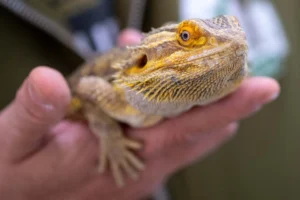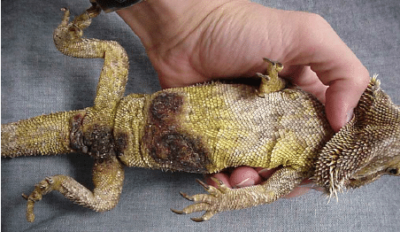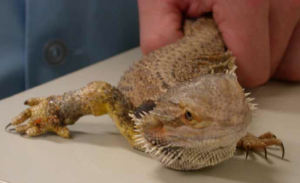Bearded dragons are fascinating reptilian companions known for their unique appearance and docile nature. However, like any pet, they can encounter health issues, one of which is yellow fungus infection. Yellow fungus, also known as ‘Yellow Fungal Disease’ (YFD), is a concerning condition that can affect bearded dragons, causing discoloration, lesions, and potentially severe health complications if left untreated.
In this guide, we’ll delve into the causes, symptoms, and most importantly, effective treatment methods for combating yellow fungus and restoring your beloved bearded dragon’s health and vitality. Let’s explore how to treat yellow fungus on bearded dragons.
Understanding Yellow Fungus

Yellow fungus, also known as canary fungus, is a concerning condition that can affect bearded dragons, among other reptiles. Here’s a tailored overview of yellow fungus specifically for bearded dragons:
- Causes: Yellow fungus in bearded dragons is often associated with poor husbandry practices, including inadequate enclosure hygiene, improper temperature and humidity levels, and unsanitary substrate. It can also occur due to stress, malnutrition, or immune system suppression.
- Symptoms: Bearded dragons with yellow fungus may exhibit symptoms such as lethargy, decreased appetite, weight loss, dark or discolored patches on the skin, swelling, sores or ulcers, and abnormal shedding. These symptoms can progress rapidly if left untreated.
- Diagnosis: Diagnosis of yellow fungus in bearded dragons is typically based on clinical signs, physical examination, and sometimes laboratory tests. A veterinarian experienced in reptile care may take skin scrapings or biopsies to confirm the presence of fungal infection.
- Treatment: Treatment of yellow fungus in bearded dragons involves a multi-faceted approach. This may include antifungal medications prescribed by a veterinarian, such as topical or systemic antifungals. Additionally, improving husbandry conditions, including maintaining proper temperature and humidity levels, providing a clean environment, and ensuring adequate nutrition, is crucial for successful treatment.
- Quarantine: Affected bearded dragons should be quarantined to prevent the spread of the fungus to other reptiles. Additionally, thorough disinfection of enclosures and equipment is necessary to eliminate fungal spores.
- Prognosis: The prognosis for bearded dragons with yellow fungus varies depending on the severity of the infection and the timeliness of treatment. Early detection and intervention can improve the chances of successful recovery, but severe cases may be more challenging to treat and may have a poorer prognosis.
- Prevention: Preventing yellow fungus in bearded dragons involves maintaining optimal husbandry conditions, including providing a clean and appropriately sized enclosure, ensuring proper temperature and humidity levels, offering a balanced diet, and minimizing stress. Regular health checks by a qualified reptile veterinarian can also help detect any potential issues early on.
Yellow fungus can be a serious health concern for bearded dragons, so prompt veterinary attention is essential if you suspect your pet may be affected. Early intervention and diligent care can greatly improve the outcome for affected individuals.
Causes and risk factors of yellow fungus on bearded dragon
Yellow fungus, also known as canary fungus, can affect bearded dragons, leading to potentially serious health complications. Understanding the causes and risk factors can help prevent its occurrence and effectively manage the condition if it does arise:
- Poor Husbandry Practices: One of the primary causes of yellow fungus in bearded dragons is inadequate husbandry practices. This includes improper enclosure hygiene, such as failure to regularly clean the tank and substrate, as well as insufficient temperature and humidity regulation within the enclosure. Inadequate living conditions can create an environment conducive to fungal growth.
- Stress: Bearded dragons subjected to chronic stress are more susceptible to yellow fungus infections. Stress can weaken their immune system, making them less capable of fighting off infections. Stressors can include overcrowding, improper handling, aggressive tankmates, or sudden changes in their environment.
- Poor Nutrition: Malnutrition or an imbalanced diet can compromise a bearded dragon’s immune system, making them more vulnerable to infections like yellow fungus. Inadequate calcium, vitamin D3, or other essential nutrients can weaken their overall health and immune response.
- Injuries or Wounds: Bearded dragons with open wounds or injuries are at higher risk of developing yellow fungus infections. Fungal spores can enter the body through these wounds, leading to localized or systemic infections if not properly treated.
- Immunocompromised Individuals: Bearded dragons with underlying health conditions or immunosuppression are more susceptible to yellow fungus infections. This includes individuals with metabolic bone diseases like metabolic bone disease (MBD), organ dysfunction, or those undergoing immunosuppressive treatments.
- Age and Environmental Factors: Young or elderly bearded dragons may be more vulnerable to yellow fungus infections due to their weaker immune systems. Additionally, environmental factors such as high humidity, poor ventilation, and the presence of organic matter (like feces or uneaten food) can promote fungal growth and increase the risk of infection.
- Previous Fungal Infections: Bearded dragons that have previously suffered from fungal infections, such as respiratory fungal infections, may be more prone to developing yellow fungus infections in the future, especially if proper preventive measures are not taken.
Understanding these causes and risk factors can help bearded dragon owners take proactive steps to prevent yellow fungus infections. This includes maintaining a clean and appropriately sized enclosure, providing proper nutrition and supplementation, minimizing stress, and promptly addressing any injuries or health concerns.
In addition, regular veterinary check-ups are also essential for early detection and treatment of any potential health issues.
Symptoms of yellow fungus in bearded dragons
Yellow fungus, also known as canary fungus, can manifest with various symptoms in bearded dragons. Recognizing these signs early is crucial for prompt veterinary intervention and effective treatment. Here are common symptoms of yellow fungus in bearded dragons:
- Yellow Discoloration: One of the hallmark symptoms of yellow fungus is the appearance of yellow or orange discoloration on the skin, scales, or shell of the bearded dragon. This discoloration may initially present as small patches or spots and can spread over time if the infection progresses.
- Lethargy: Infected bearded dragons may appear lethargic or sluggish. They may spend more time resting than usual and exhibit decreased activity levels, including reduced movement and exploration within their enclosure.
- Decreased Appetite: Yellow fungus infections can cause a loss of appetite in affected bearded dragons. They may show little interest in eating or refuse food altogether, leading to weight loss and nutritional deficiencies if left untreated.
- Skin Lesions or Sores: As the infection progresses, bearded dragons may develop skin lesions, sores, or ulcers in areas affected by the fungus. These lesions may be accompanied by inflammation, swelling, or discharge and can cause discomfort or pain for the reptile.
- Abnormal Shedding: Yellow fungus infections can disrupt the bearded dragon’s normal shedding process. Affected individuals may experience incomplete or irregular shedding, leading to retained shed skin, which can further exacerbate skin irritation and infection.
- Swelling or Edema: In severe cases of yellow fungus infection, bearded dragons may develop swelling or edema in affected areas. This swelling may be accompanied by redness, warmth, or tenderness and can indicate inflammation and tissue damage.
- Respiratory Symptoms: In some cases, yellow fungus infections can extend beyond the skin and affect the respiratory system. Bearded dragons may exhibit symptoms such as wheezing, difficulty breathing, nasal discharge, or open-mouth breathing, indicating respiratory involvement.
- Generalized Illness: Bearded dragons with yellow fungus infections may display signs of generalized illness, including weakness, dehydration, and a compromised immune response. These symptoms can indicate systemic involvement and should be taken seriously.
It is essential you know that the severity and combination of symptoms can vary depending on the stage of the infection and the individual bearded dragon’s health status. If you notice any of these signs in your bearded dragon, it’s crucial to seek veterinary care promptly for an accurate diagnosis and appropriate treatment.
Furthermore, early intervention can improve the chances of successful recovery and minimize potential complications associated with yellow fungus infections.


